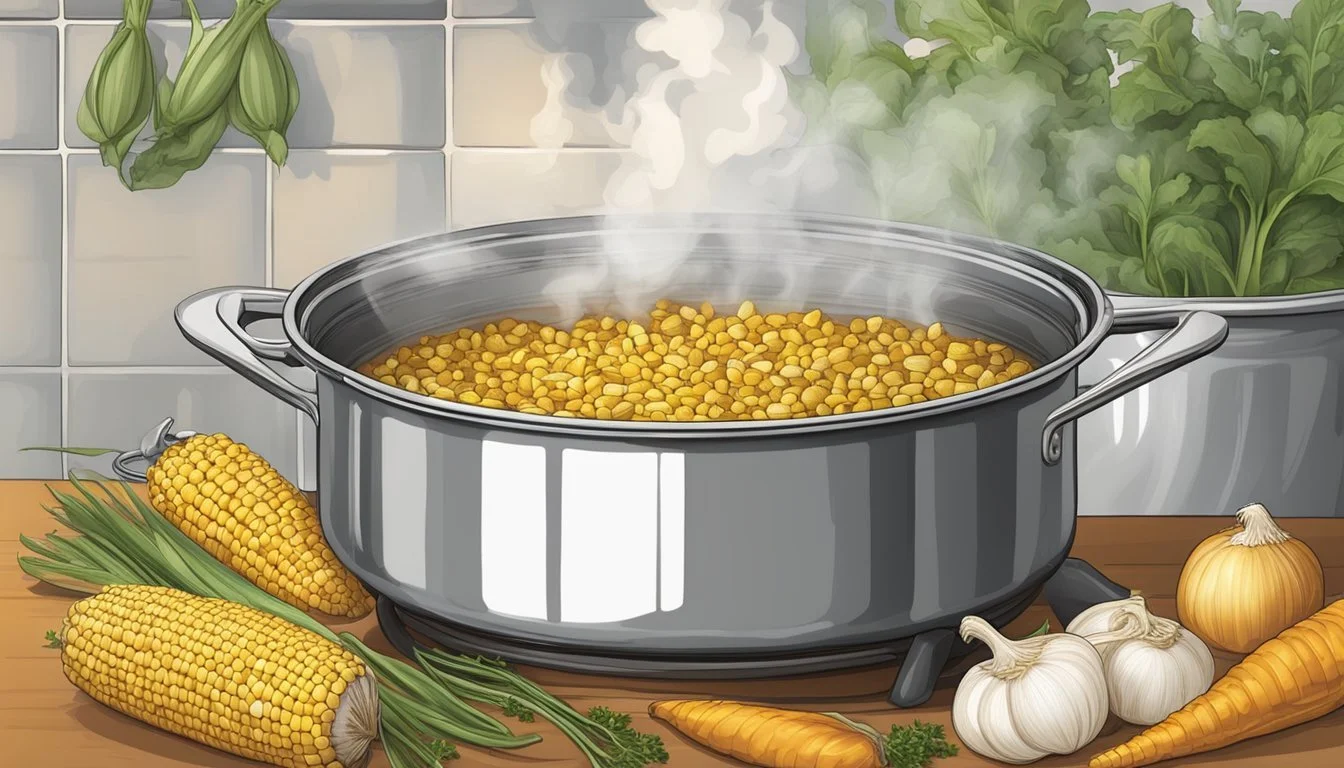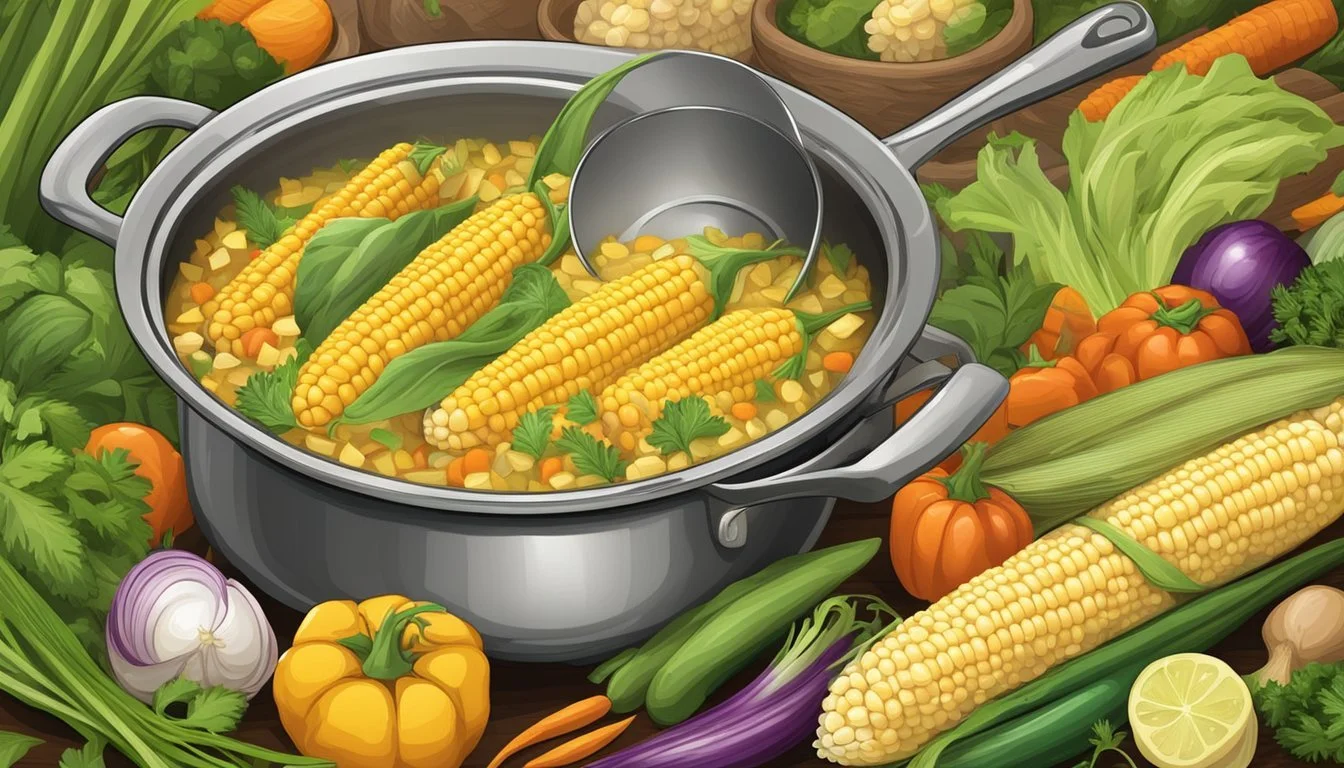Corn Cob Stock
The Secret Ingredient for Hearty Soups and Stews
Corn Cob Stock is a treasure often overlooked in the culinary world. This flavorful broth, crafted from the remnants of corn cobs once the kernels have been removed, is an ingenious way to utilize kitchen scraps that might otherwise go to waste. The stock serves as a hearty base for both soups (What wine goes well with soups?) and stews (What wine goes well with stews?), infusing them with a subtle sweetness and depth of flavor unique to the essence of corn.
Cooking Corn Cob Stock is a straightforward process, typically involving the simmering of stripped cobs with herbs, vegetable scraps, and water. It differs from other vegetable stocks due to the natural starches and sugars released from the cobs, which lend dishes a velvety texture and a rich, rounded taste. Whether simmered on the stovetop, left to meld flavors in a slow cooker, or prepared in an Instant Pot, the stock is a versatile ingredient that can elevate an array of recipes.
Many cultures incorporate corn as a staple grain, but the innovation of using corn cobs in stock is a testament to culinary creativity. By infusing this essence into soups and stews, chefs and home cooks alike can bring a new dimension of flavor to traditional recipes. The stock can also be used to enhance the taste of corn-based dishes like cornbread, corn cakes, and corn pudding, ensuring that nothing goes to waste and each meal is as savory as it is sustainable.
Exploring the Basics of Corn Cob Stock
Creating corn cob stock is a simple yet effective way to impart a sweet corn flavor and rich body to various dishes. This homemade kitchen essential harnesses the natural goodness of corn cobs to enhance soups, stews, and more.
Defining Corn Cob Stock
Corn cob stock is a liquid made by simmering corn cobs, often with aromatic vegetables and herbs, in water over an extended period. This process extracts the subtle, sweet flavors of corn and imbues the stock with a depth that store-bought versions typically lack. Suitable for vegetarian and vegan recipes, corn cob stock provides a robust foundation for an array of culinary creations.
Nutritional Value of Corn Stock
Corn stock is not only flavorful but also delivers nutritional benefits:
Fiber: While most of the fiber remains in the solid corn cob itself, some soluble fiber may infuse into the stock during the simmering process.
Vitamin C and Potassium: Corn cobs contain these nutrients, which can leach into the stock providing additional nutrition to any dish it is used in.
When preparing corn cob stock, chefs can healthily enhance the taste profiles of their dishes with a homemade stock that is devoid of additives commonly found in commercial versions.
Preparation Essentials
Creating a flavorful corn cob stock begins with careful selection of ingredients and the use of fresh corn cobs to ensure a rich and aromatic base for culinary creations.
Selecting Quality Ingredients
Ingredients form the foundation of a great corn cob stock. One should opt for organic, locally-sourced produce whenever possible to guarantee the freshest taste and minimal exposure to unwanted chemicals. Essential vegetables like carrots, celery, and onions contribute to the depth of flavor, each bringing their own hint of sweetness, savoriness, and pungency to the stock. Garlic serves as a key aromatic, adding a subtle bite that complements the natural sweetness of the stock.
Sweet Corn: Ensure that the corn is fresh, as it is the star of the stock. The cobs should be firm and the kernels plump and juicy.
Spices: Fresh herbs like thyme or parsley, along with black peppercorns, can be added to personalize the stock's flavor profile.
The Importance of Fresh Corn Cobs
For an outstanding corn cob stock, the freshness of the corn cobs is non-negotiable. They should be sourced at the height of sweetness, typically in mid-to-late summer when they are at peak freshness. After removing the sweet corn kernels for other dishes, the naked cobs harbor a considerable amount of flavor within their cores and husks.
Freshness Check: Inspect the corn cobs for a bright green husk, moist stems, and silk ends that are free of decay.
Storage: If not used immediately, fresh corn cobs can be stored in the refrigerator for up to two days to maintain their flavor integrity.
Corn Cob Stock Methodology
The methodology behind corn cob stock revolves around a slow and steady simmering process that extracts the rich, sweet flavors from the leftover cobs. This section will guide you through the detailed process and provide tips to ensure a flavorful stock.
Step-by-Step Cooking Process
Preparation: Begin by removing the husks, silks, and kernels from corn cobs. Save the kernels for another dish or freeze for later use.
Boiling: Place the cleaned corn cobs in a large pot and cover them with water. For enhanced flavor, include herbs such as parsley, thyme, and bay leaves, as well as a teaspoon of black peppercorns.
Cook Time: Bring the pot to a boil, then reduce the heat to achieve a gentle simmer.
Simmering: Allow the stock to cook, uncovered, for about 1 hour. This step is crucial for flavor development.
Finishing: After the total time of simmering, which should be between 1 to 1.5 hours, the flavors will be fully infused into the stock.
Straining and Storing: The next step involves straining the stock to remove all solids. Once strained, discard the solids and let the stock cool before transferring it to storage containers.
Expert Tips for Simmering and Boiling
Flavor Extraction: The key to a rich stock is to simmer at a low temperature for an extended period, which allows full extraction of flavors without boiling off the volatile compounds that deliver the stock's signature taste.
Avoid Overcrowding: Ensure there's enough water to cover the ingredients by about an inch, allowing the ingredients to move freely and the heat to distribute evenly.
Herbs and Spices: Bundled parsley, thyme, and a couple of bay leaves add complexity, while black peppercorns impart a subtle heat. Adjust these to taste, but remember that the stock should complement and not overpower the flavors of the final dish.
Clarity: For a clearer stock, use a fine mesh strainer or cheesecloth when straining to remove fine particles.
Skimming: Occasionally skim off any impurities that rise to the surface during the simmering process to produce a cleaner flavor and appearance.
Following these specific steps and tips will result in a corn cob stock with robust flavor and versatility for your soups, stews, and more.
Versatility in Recipes
Corn cob stock is a robust foundation that enhances the taste profiles of various recipes. Its sweet, nuanced flavor makes it an ideal liquid base for enriching the taste of soups and expanding the culinary possibilities across different cuisines.
Infusing Flavor into Soups and Risottos
Corn cob stock can be the secret ingredient in elevating the taste of soups and risottos. It imparts a subtle sweetness that pairs well with the creamy texture of risotto or the heartiness of a chowder. Chefs can replace the traditional chicken or vegetable stock with corn cob stock in their favorite soup recipes, such as:
Chicken tortilla soup: Offering a deeper flavor that complements spices.
Vegetable risotto: Adding an additional layer of sweetness to the rice.
Corn cob stock can also provide a unique twist to classic rice dishes. Incorporating this stock into a Mexican Street Corn style risotto, for example, can infuse the dish with the iconic flavors of the beloved street food.
Adapting Corn Stock for Various Cuisines
Corn cob stock's adaptability extends to various global cuisines. Its inherent sweetness can balance out spicy, bold flavors, while its subtle corn undertone can support and enhance specific cultural dishes. Here are specific adaptations:
Mexican cuisine: Use it as a base for a corn and poblano soup or to add depth to Mexican street corn inspired dishes.
Italian cuisine: Incorporate it in pasta sauces or as a liquid base for polenta, enhancing the corn flavor in the dish.
American cuisine: Create a sweet and creamy corn salad dressing or boost a corn chowder with an extra punch of flavorful authenticity.
Corn cob stock showcases its ability to be seamlessly integrated into a variety of recipes, proving its utility beyond just a simple stock. Chefs and home cooks alike can experiment with it across their culinary ventures to add a unique and satisfying depth of flavor.
Enhancing and Expanding Flavor Profiles
Creating a base for soups and stews, corn cob stock brings a sweet and robust flavor, emblematic of summer's bounty. Using complementary ingredients and exploring versatile applications can elevate this stock to be a foundation for an array of dishes.
Complementing Ingredients for Corn Stock
To enhance the natural sweetness of corn flavor, one can incorporate fresh herbs like rosemary or thyme, which add a complex aroma and depth to the stock. Vegetables such as onions, carrots, and celery act as the classic mirepoix, while garlic can contribute a subtle, piquant note. Here is a simple table of ingredients that pair well with corn stock:
Ingredient Purpose Fresh Herbs Introduce aromatic depth (e.g., rosemary) Mirepoix Add foundational flavors Garlic Provide pungency and depth
These ingredients not only complement the stock but also lay a versatile groundwork for other recipes, aligning with the full expression of summer flavors.
Creative Uses Beyond Soups
While soups are a natural home for corn cob stock, its use in other dishes can be equally rewarding. One can enrich sauces for pasta or polenta, providing a subtle undertone that pairs wonderfully with rich, savory toppings. Corn stock can be the secret ingredient in cornbread, adding moisture and enhancing the corn flavor. It also lends itself well to corn fritters, where it can be used in the batter or as a base for a complementary dipping sauce.
Polenta: The stock can be used to cook polenta, bringing a corn-centric flavor that echoes the main ingredient.
Cornbread: Utilize the stock for added depth and moisture.
Corn Fritters: Combine with the batter or use as a base for sauces that accent the fritters.
By integrating corn cob stock into these dishes, chefs can deliver the taste of summer year-round through versatile and inventive culinary applications.
Seasonal and Dietary Considerations
When preparing corn cob stock, cooks should take into account the abundance of corn during the summer season as well as its adaptability for various dietary preferences, including vegan, vegetarian, and gluten-free diets.
Maximizing Corn Stock in Summer Recipes
Summer brings a bounty of fresh corn, providing an excellent opportunity to make homemade corn cob stock. The sweet, fresh flavor of summer corn can enhance light seasonal dishes such as chilled soups or summer vegetable stews. When corn is at its peak, one can freeze the stock to preserve the taste of summer for use throughout the year.
Corn Cob Stock for Special Diets
Corn cob stock is inherently gluten-free and suitable for both vegan and vegetarian diets, making it a versatile base for various soups, stews, and other recipes. When preparing this stock, chefs should ensure all added ingredients comply with these dietary considerations. Here's a brief guide to ensure alignment with special diets:
Dietary Requirement Considerations for Corn Cob Stock Vegan Avoid animal-derived ingredients, such as butter or meat-based broths. Vegetarian Exclude meat, poultry, and fish. Dairy can be included if desired. Gluten-Free Confirm all additions, like sauces or seasonings, are certified gluten-free.
Using corn cob stock in recipes caters to diverse dietary needs while adding depth and flavor to countless dishes.
Storage Solutions
Proper storage of corn cob stock ensures that the rich flavors are preserved for future culinary uses. The key to maintaining the quality of the stock lies in appropriate cooling, sealing, and temperature control.
Preserving Corn Cob Stock for Future Use
After cooling the stock to room temperature, the next step in preservation is portioning it out for ease of use. One should consider the typical recipes they intend to use the stock for and divide it accordingly. Mason jars or other airtight containers are excellent choices for storage as they prevent exposure to air, which can cause deterioration. Labeling containers with the date of creation is essential for tracking freshness.
Freezing and Refrigerating Techniques
Refrigerator: For short-term storage, the refrigerator is a suitable option. Corn cob stock can be kept in the refrigerator for up to 4 days when placed in an airtight container to retain its flavor and prevent spoilage.
Freezer: For long-term preservation, freezing the stock is the preferred method. Using an airtight container or freezer-safe bags, one can freeze the stock in usable portions. Here’s a simple guideline to follow:
Pour: Place cooled stock into containers, leaving an inch of headspace to allow for expansion.
Seal: Ensure the container is sealed tightly to prevent freezer burn.
Store: Place in the freezer where the stock can last for up to 6 months.
Remember to thaw the stock in the refrigerator overnight before using it in recipes. The consistency and flavor of the corn cob stock will remain intact through this process.
Efficient Kitchen Practices
Maximizing the use of every ingredient and utilizing the proper tools can vastly improve kitchen efficiency, especially when making corn cob stock.
Managing Food Waste with Corn Cobs
One should not overlook leftover corn cobs as they are a prime example of kitchen resourcefulness. Instead of discarding them, corn cobs serve as the foundation for a flavorful stock, thus reducing food waste. If the cobs cannot be used immediately, they can be frozen for later use or added to a compost pile as a green material, which can benefit garden soil.
Kitchen Tools for Preparing Corn Stock
Preparing corn stock requires a few essential tools to ensure a smooth process. A sharp knife is necessary to safely remove the kernels from the cobs, thereby preparing them for use. The cobs are then simmered in water, and a fine-mesh strainer or cheesecloth comes in handy to clarify the stock by removing the solids. During the preparation, the use of a sturdy cutting board provides a secure surface and aids in maintaining kitchen safety.
Final Touches and Serving Suggestions
Crafting a delicious meal comes down to the final touches and the pairing choices one makes. This section delves into garnishing soups enhanced with corn cob stock and selecting the perfect drink pairings for these comforting dishes.
Garnishing and Enhancing Soups
When serving soups based on corn cob stock, such as the hearty Corn Chowder, garnishing plays a key role. A sprinkle of fresh chives or parsley adds a pop of color and a herby freshness. For texture, consider garnishing with crispy bacon bits or a dollop of sour cream. For those who enjoy a bit of heat, a light drizzle of chili oil or a few red pepper flakes can elevate the dish substantially.
Pairing Drinks with Corn Cob Stock-Based Dishes
Selecting the right drink to accompany a soup or stew can enhance the dining experience. For corn cob stock-based dishes, consider the following pairings:
For Corn Chowder or other rich, creamy soups:
White wines such as Chardonnay or Sauvignon Blanc cut through the richness with their acidity.
Light-bodied beers like Pilsners or Wheat Ales complement the creaminess without overpowering the dish.
With lighter broths or salads featuring corn:
A Pinot Grigio or a Sparkling White can provide a refreshing contrast.
Iced Herbal Teas can also be a palate-cleansing option.
Each pairing is intended to balance the dish's flavors and enhance the overall enjoyment. It's always a good idea to offer a variety of drink options to cater to different preferences.
Remember to serve Corn Cob Stock-based soups with a side of Crusty Bread to soak up all the flavorful broth, crafting the ultimate comfort meal.





